
The Top 10 Planes With The Longest Range
Discover the top commercial planes with the longest range in the world, capable of flying nonstop for thousands of miles without refueling.
Table of Contents
One of the greatest advantages of modern jet aircraft is that they enable us to connect two destinations relatively quickly. Therefore, the range of these aircraft is an essential factor that manufacturers consider when developing new passenger aircraft.
This article lists the ten commercial passenger jet planes with the longest range. But before we get started, we have to explain some background information.
The ranges are without refueling en route, and the figures are with passengers. Longer ranges are possible with empty aircraft. The aircraft on the list must also be jets, and they must be in use (or relatively recently) by airlines or close to complete development by manufacturers.
Let's look at the list of the ten longest-range commercial airliners.
The Top 10 Planes With The Longest Range
Several factors are essential when airlines buy new aircraft. Their ranges are sometimes one of those if the company operates very long routes or intends to do so.
We have summarized a list of the ten commercial airliners with the longest range in the table below. We dive deeper into each plane, further down the page.
| Rank | Manufacturer | Model | Miles | Km |
|---|---|---|---|---|
| 1 | Airbus | A350-900ULR | 11,185 | 18,000 |
| 2 | Airbus | A340-500 | 10,358 | 16,670 |
| 3 | Boeing | 777-8 | 10,048 | 16,170 |
| 4 | Airbus | A350-1000 | 10,004 | 16,100 |
| 5 | Boeing | 777-200LR | 9,844 | 15,843 |
| 6 | Airbus | A350-900 | 9,552 | 15,372 |
| 7 | Airbus | A330-800 (Neo) | 9,379 | 15,094 |
| 8 | Airbus | A380-800 | 9,196 | 14,800 |
| 9 | Boeing | 747-8i | 8,898 | 14,320 |
| 10 | Boeing | 787-9 | 8,786 | 14,140 |
Data is from March 2023.
No. 10 - Boeing 787-9
Range: 8,786 miles (14,140 km)
In 10th place on the list of aircraft with the longest range, we find Boeing's 787 Dreamliner, specifically the 787-9 variant.
The Dreamliner is a twin-engine airliner that first flew in 2009 and entered commercial service in 2011 with All Nippon Airways.
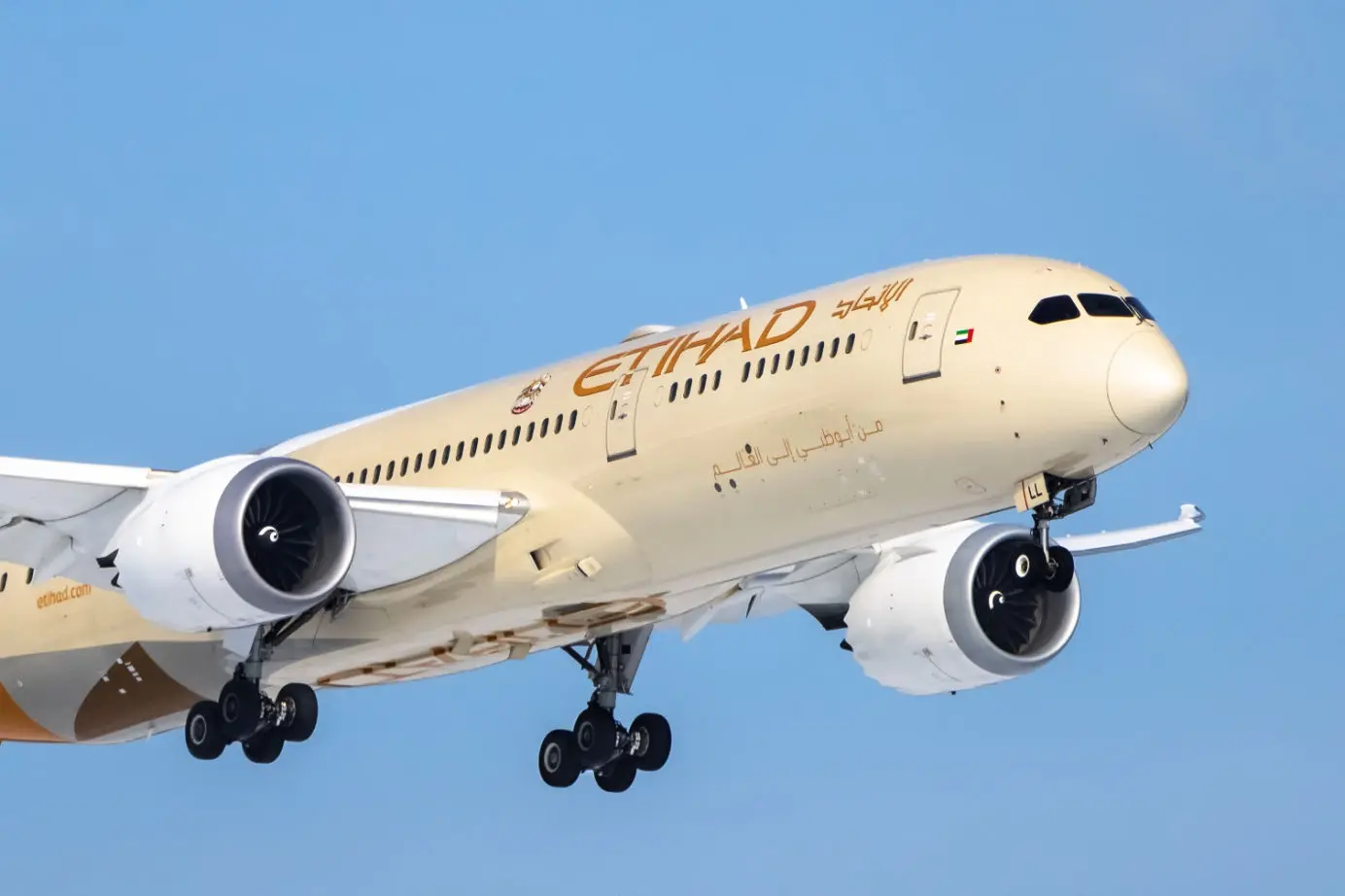
One of the unique things about the Boeing 787 is that it is the first airliner primarily made of composite materials. That offers several advantages, including considerable weight savings, which make the aircraft more fuel-efficient and, therefore, better for the environment. According to Boeing, the Dreamliner is 20% more fuel efficient than the aircraft it replaces.
The improved fuel economy and highly efficient airframe design give the Boeing 787 an attractive range for airlines. Boeing offers the Dreamliner in three variants, with different lengths and passenger capacities. The 787-9 variant has the longest range and can fly 8,786 miles (14,140 km) with 290 passengers. This variant entered commercial service in 2014 with All Nippon Airways.
According to Boeing, passengers will also notice a difference when flying on a Dreamliner. Cleaner cabin air, lower humidity, less noise, and lower air pressure in the cabin should make the trip more comfortable and reduce fatigue.
No. 9 - Boeing 747-8i
Range: 8,898 miles (14,320 km)
At number 9 on the list, we find one of the most well-known aircraft in the history of aviation - The Boeing 747 "Jumbojet" in the latest variant, the 747-8i. It is the largest variant of the 747 and has a range of 8,898 miles (14,320 km) with 467 passengers in a typical three-class configuration.
Boeing launched the 747-8 series on November 14, 2005, in two variants: A passenger and a cargo variant. The passenger version 747-8i (i for Intercontinental) first flew on March 20, 2011.
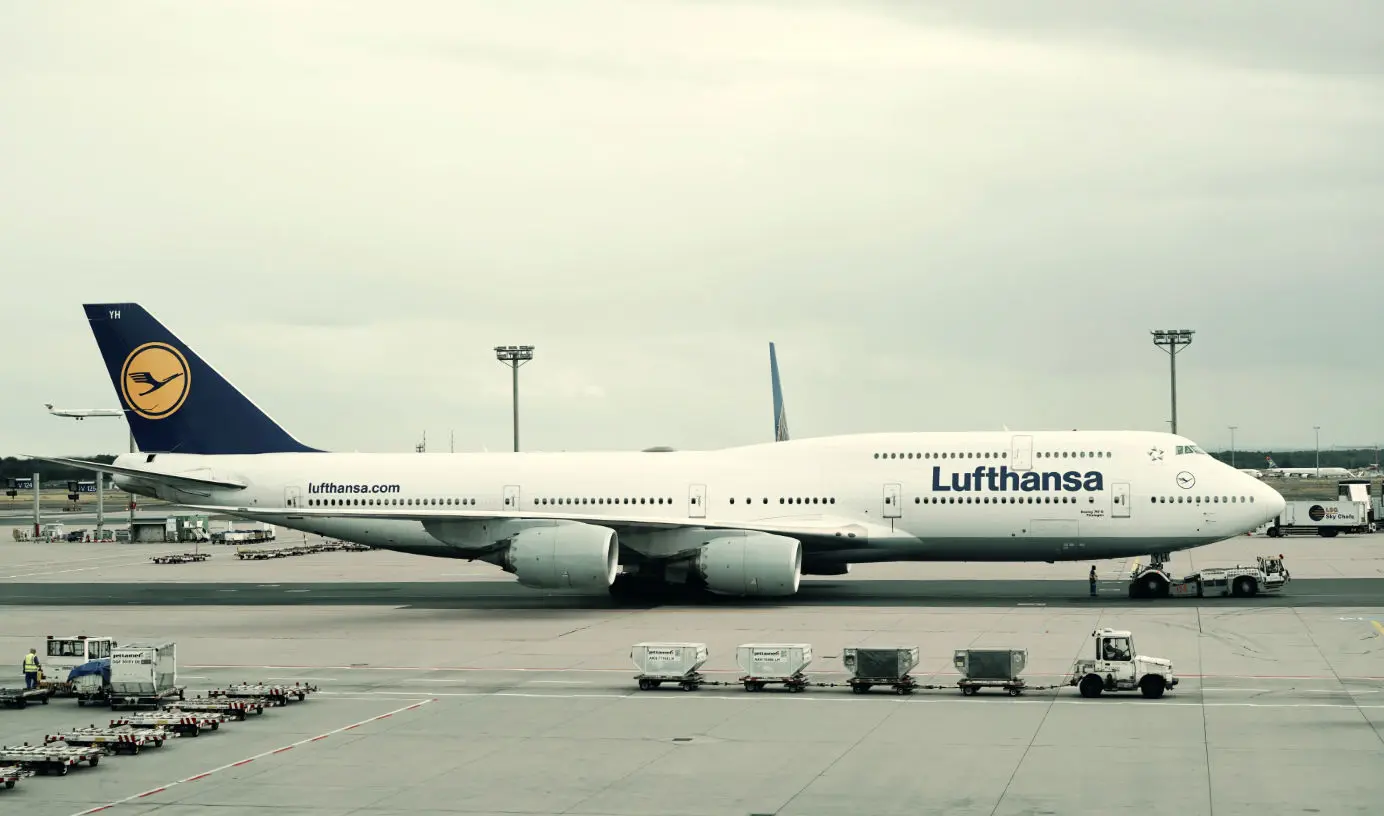
During the development of the 747-8, Boeing borrowed a lot of technology from their 787 Dreamliner to modernize and update several designs and systems on board. Much of this work aimed to make the 747 more fuel efficient and more attractive to airlines.
Overall, the 747-8i is similar to the other 747s, and the aircraft has retained its basic structure and wing design. But Boeing also made the wings thicker and wider to hold more fuel. In addition, Boeing equipped the 747-8i with the same highly efficient General Electric GEnx turbofan engine as the 787 Dreamliner, contributing to lower fuel consumption and longer range. At the same time, the aircraft's maximum take-off weight (MTOW) grew to 987,000 pounds (448 t), making it Boeing's heaviest airliner.
However, declining demand for both the passenger and cargo versions led Boeing to end the 747 production. Boeing built a total of 48 aircraft of the passenger variant 747-8i. The 747 program concluded when, in January 2023, Boeing delivered the last 747, a freighter version, to Atlas Air.
The historic 747 jumbo jet revolutionized aviation and enabled more people to fly farther, faster, and cheaper than ever before. Boeing produced 1,574 747s in total.
No. 8 - Airbus A380-800
Range: 9,196 miles (14,800 km)
Another very familiar plane takes eighth place on the list. It is the Airbus A380 that, with its full-length double deck, is easily recognizable and makes it the world's largest passenger aircraft. The Airbus A380 has four engines (Engine Alliance GP7200 or Rolls-Royce Trent 900 turbofans), giving the aircraft a range of 9,196 miles (14,800 km).
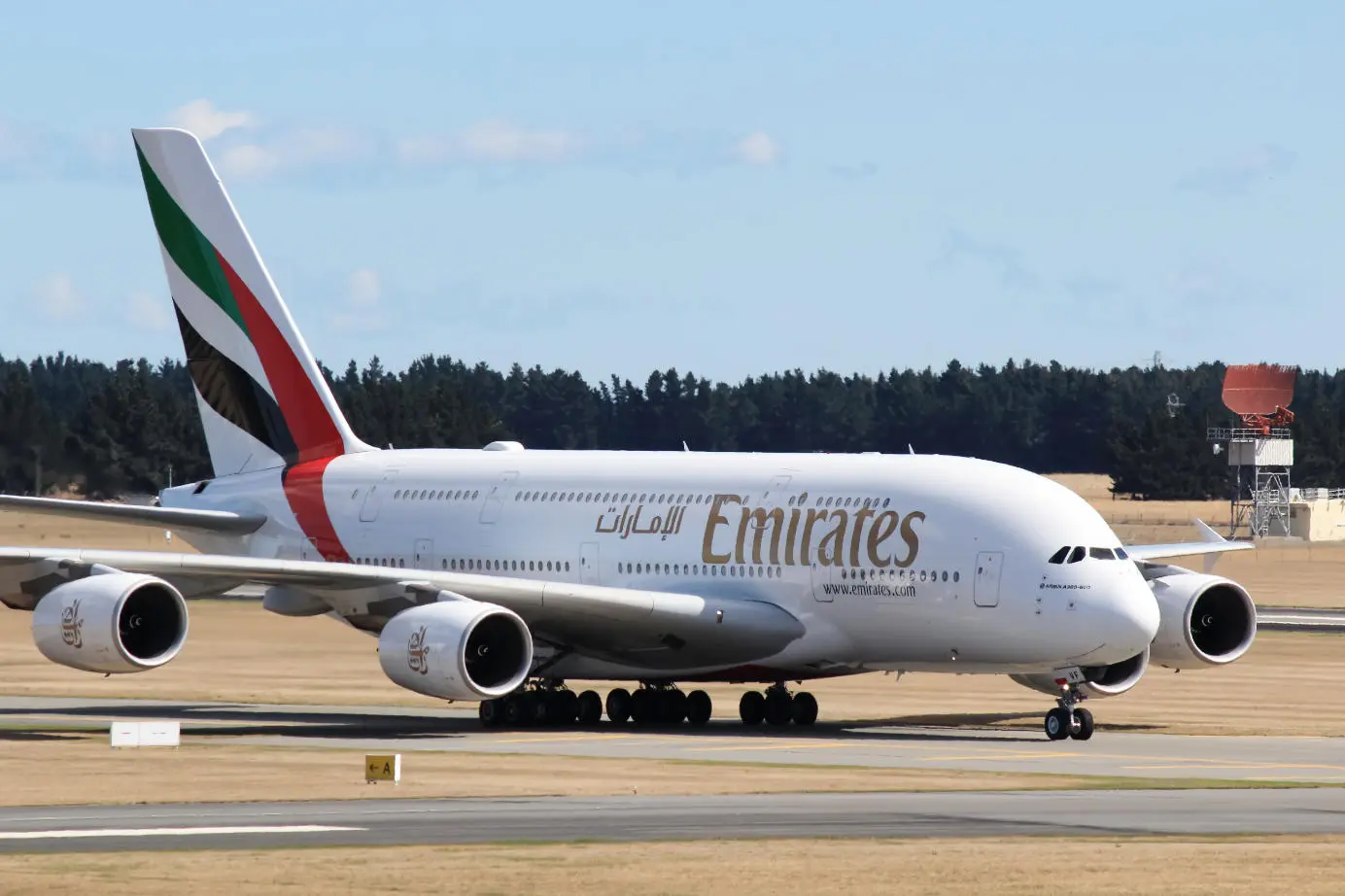
Airbus launched the first A380 prototype in Toulouse on January 18, 2005, and the aircraft first flew on April 27, the same year. The first production A380s was delivered to Singapore Airlines on October 15, 2007, and was put into service ten days later.
Due to the aircraft's double deck, the A380 has a very high passenger capacity. In a typical standard configuration, it can carry 525 passengers, but the A380 is actually certified to carry 853 passengers. This makes the A380 the aircraft with the highest passenger capacity in the world.
With the A380, Airbus attempted to capture parts of the international aircraft market for "jumbo jets" that Boeing had dominated with their 747s since its introduction in 1968. For a time, Airbus was actually successful in this attempt as the production of the A380 peaked in 2012 and 2014, respectively, with 30 aircraft produced per year.
However, when the largest customer, Emirates, reduced their order for A380 aircraft in 2019, Airbus was forced to stop production in 2021. The last Airbus A380 flew for the first time on March 17, 2021, and was delivered to Emirates on December 16, 2021. Airbus built a total of 254 A380s.
No. 7 - Airbus A330-800 (Neo)
Range: 9,379 miles (15,094 km)
Airbus' A330-800 (Neo) wide-body, twin-engine airliner is in seventh place.
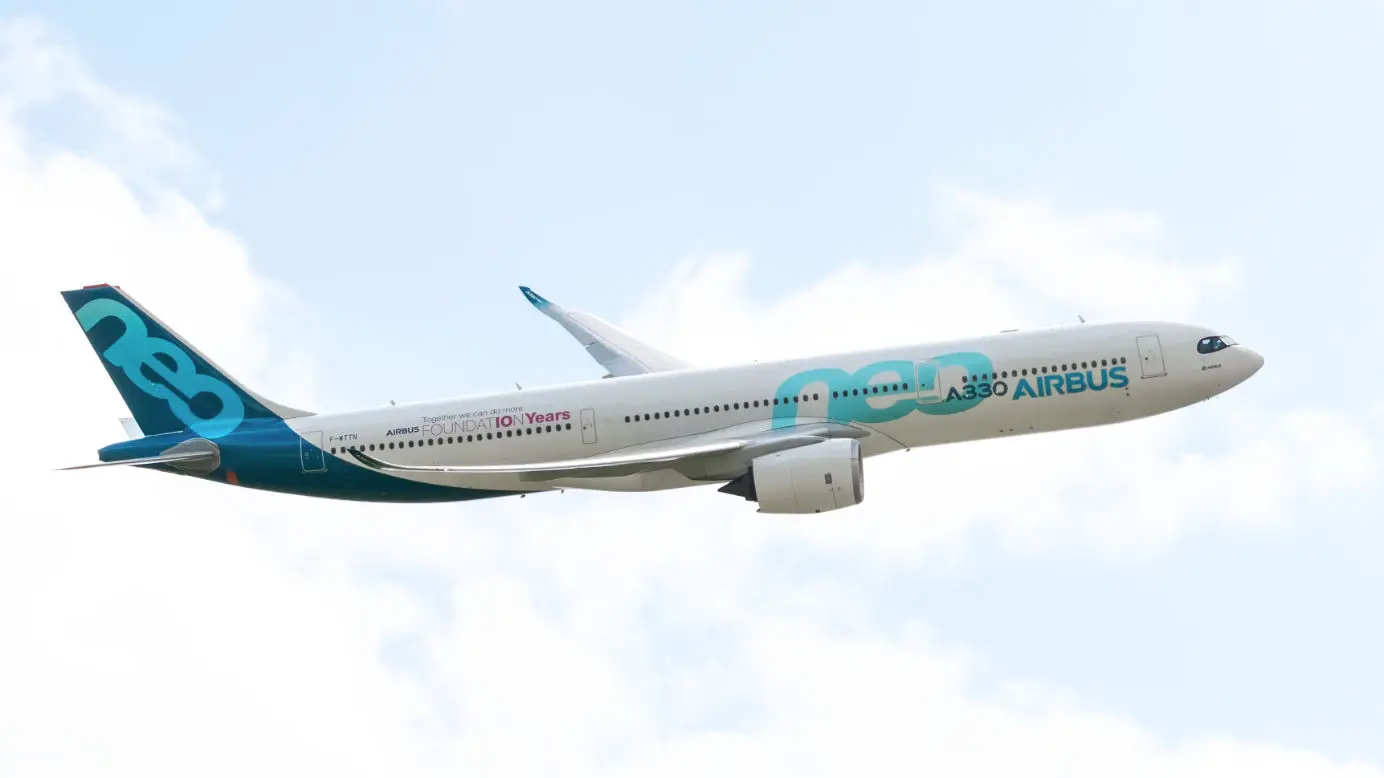
This aircraft, an evolution of the Airbus A330, was announced on July 14, 2014, and is powered exclusively by two Rolls-Royce Trent 7000 engines. Thanks to the new engines, sharklets on the wingtips, and many other technologies borrowed from the Airbus A350, the A330neo has a 14% better fuel consumption per seat, according to Airbus. The passenger cabin has also been upgraded with more space, wider seats, and LED lighting. The aircraft's range has also been improved, and it can accommodate more seats than its predecessor.
The Airbus A330neo comes in two variants with different lengths and capacities. Here it is the shortest variant, the A330-800, with a range of 9,379 miles (15,094 km).
Although the A330-800 has the longest range in the A330 family of aircraft, Airbus has not seen high demand for the plane. This is partly because the previous generation A330s are not yet old enough to be replaced by the Neo. In addition, the larger A330-900 has several other advantages not necessarily justified by the range advantage of the A330-800.
What both A330neo variants have in common, however, is that they share the same type rating as the Airbus A350. Pilots can fly both aircraft under the same license with just eight extra training days.
The Airbus A330neo (a -900 variant) first flew on October 19, 2017, and entered commercial service with TAP Air Portugal on December 15, 2018.
No. 6 - Airbus A350-900
Range: 9,552 miles (15,372 km)
Airbus ranks six on the list of aircraft with the longest range, with their A350-900 long-range, twin-engine airliner. The Airbus A350 comes in two variants. The A350-900 typically carries between 300 and 350 passengers, and the extended A350-1000 between 350 and 410 passengers.
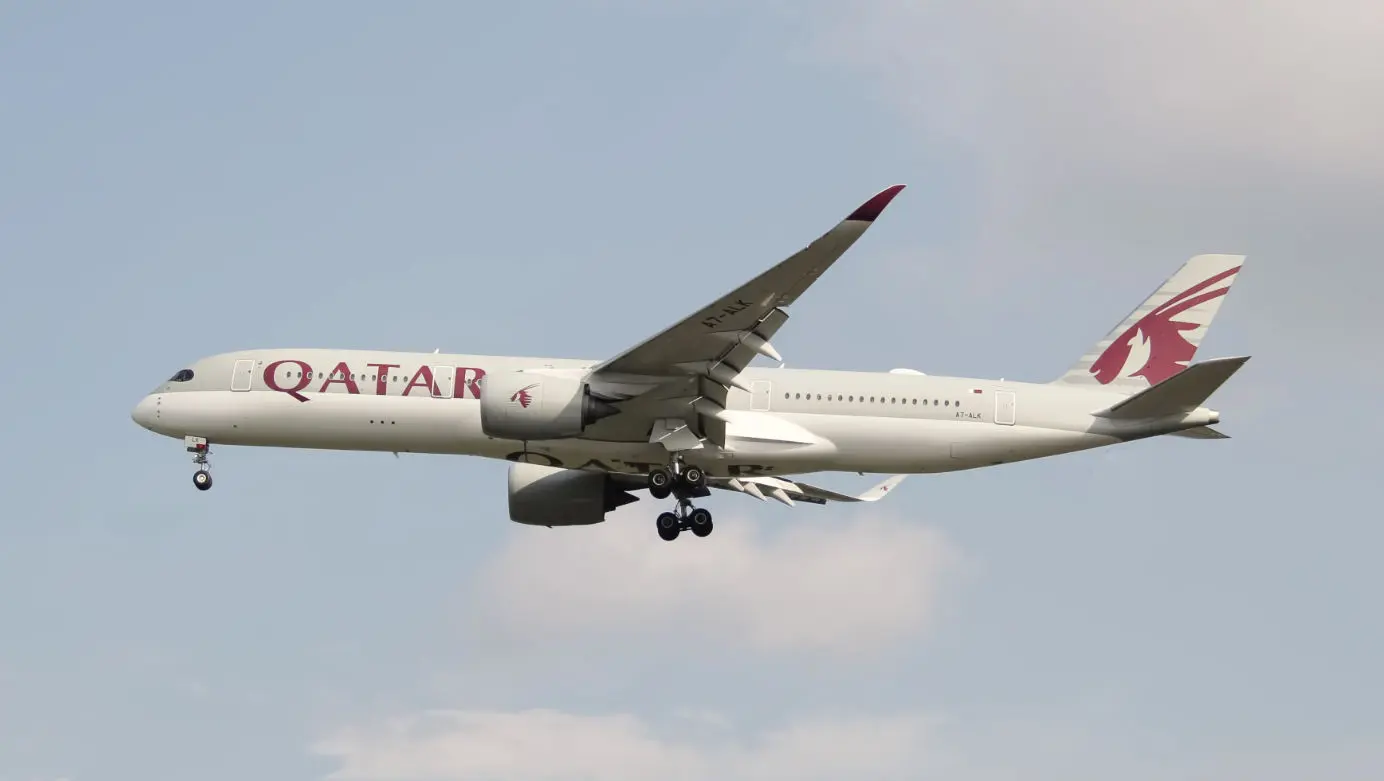
With the A350, Airbus emphasized fuel efficiency and the environment. Airbus says the A350 delivers a 25% reduction in fuel consumption (and CO2 emissions) per seat. The aircraft has been developed from scratch, a so-called clean-sheet design, and is not an upgrade from other Airbus aircraft families. The cockpit has also received several upgrades.
The extensive use of composite materials makes the Airbus A350 unique. It is Airbus' first aircraft made primarily of carbon fiber-reinforced materials. That contributes to a lower overall weight and fuel consumption, and CO2 emissions. The A350 airframe is made of 53% composite materials.
The aircraft is equipped with two Rolls-Royce Trent XWB turbofan engines, which, according to Airbus, are the quietest engine in their class. At the same time, they are the most efficient large engines in operation.
The direct competitors to the Airbus A350 are Boeing's 787 Dreamliner (also made mainly of composite materials), the Boeing 777, and its successor, the 777X.
The Airbus A350 first flew on June 14, 2013. Qatar Airways was the first airline to put it in commercial service on January 15, 2015.
No. 5 - Boeing 777-200LR
Range: 9,844 miles (15,843 km)
Boeing's popular 777, often called the "Triple Seven," is in fifth place. Specifically, the 777-200LR variant ("LR" for Long-range). It is a long-haul, wide-body airliner with two engines and a passenger capacity of between 301 and 368 passengers in a typical three-class configuration. The aircraft has a range of 9,844 miles (15,843 km).

Most people who have tried long-haul flights have most likely flown on a Boeing 777, as it is a popular choice among airlines for long-haul. In fact, the 777 has been so successful that in March 2018, the aircraft overtook the Boeing 747 as Boeing's most produced wide-body jet.
Boeing developed the 777 to fill the market gap between their four-engine 747 and twin-engine 767. In addition, the 777 was also supposed to replace the McDonnell Douglas DC-10s and Lockheed L-1011 trijets. The Boeing 777 first flew on June 12, 1994, and was introduced into service on June 7, 1995, with United Airlines.
The 777-200LR variant is a later evolution of the original 777, and the LR entered service in 2006. Boeing aimed to extend the range, and the 777-200LR is therefore intended for "ultra long-haul" routes, like Singapore to Los Angeles.
In November 2013, Boeing announced the successor to the 777, called the 777X, which comes in two variants. Special features of the 777X are the aircraft's composite wings with folding wingtips and new, more fuel-efficient General Electric GE9X engines.
The Boeing 777-200LR is powered by two General Electric GE90-110B1 or GE90-115B turbofan engines. The aircraft competes directly with the Airbus A350 and A330neo.
No. 4 - Airbus A350-1000
Range: 10,004 miles (16,100 km)
Another Airbus A350 variant has made the list. It is the Airbus A350-1000 variant with a range of 10,004 miles (16,100 km).
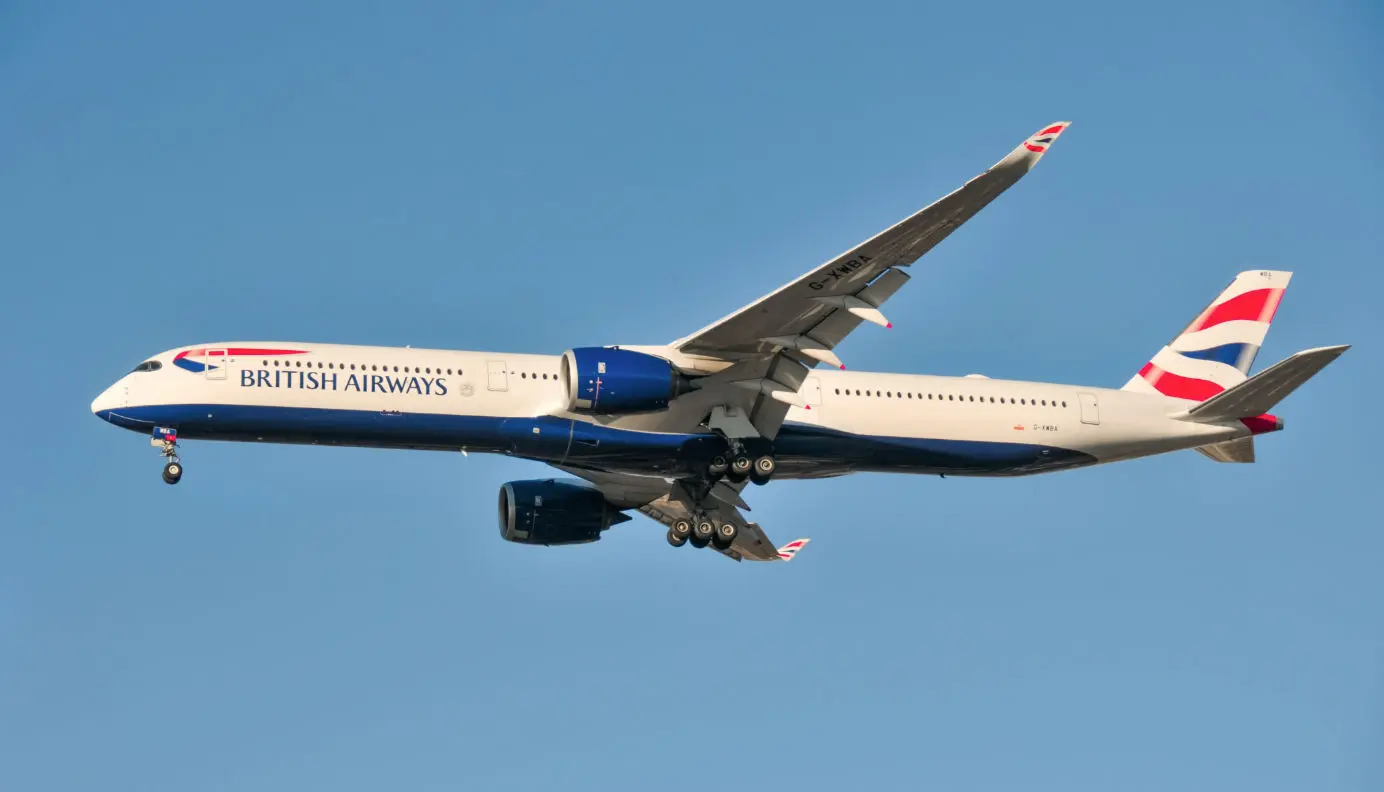
Like the A350-900, the -1000 is built to be more fuel efficient and primarily composed of composite materials. The A350-1000 has space for 350 to 410 passengers in a standard three-class cabin configuration.
The Airbus A350-1000 variant is the largest in the A350 family and is 243 feet (74 meters) long. It is a stretched version of the A350-900 and features slightly larger wings. In addition, the Rolls-Royce Trent XWB engines have also received a slight upgrade in thrust (97,000 lbf / 430 kN). These improvements help give the -1000 its long range.
The A350-1000 is intended to replace the Airbus A340-600 and competes against the Boeing 777-300ER and 777-9. Airbus claims the A350-1000 burns 25% less fuel than Boeing's 777-300ER.
No. 3 - Boeing 777-8
Range: 10,048 miles (16,170 km)
Boeing's successor to their 777 is in third place on the list. It is the upcoming Boeing 777-8, from Boeing's latest series of long-haul, wide-body, twin-engine airliners. The 777-8 has a range of 10,048 miles (16,170 km) and is expected to be ready in 2025.
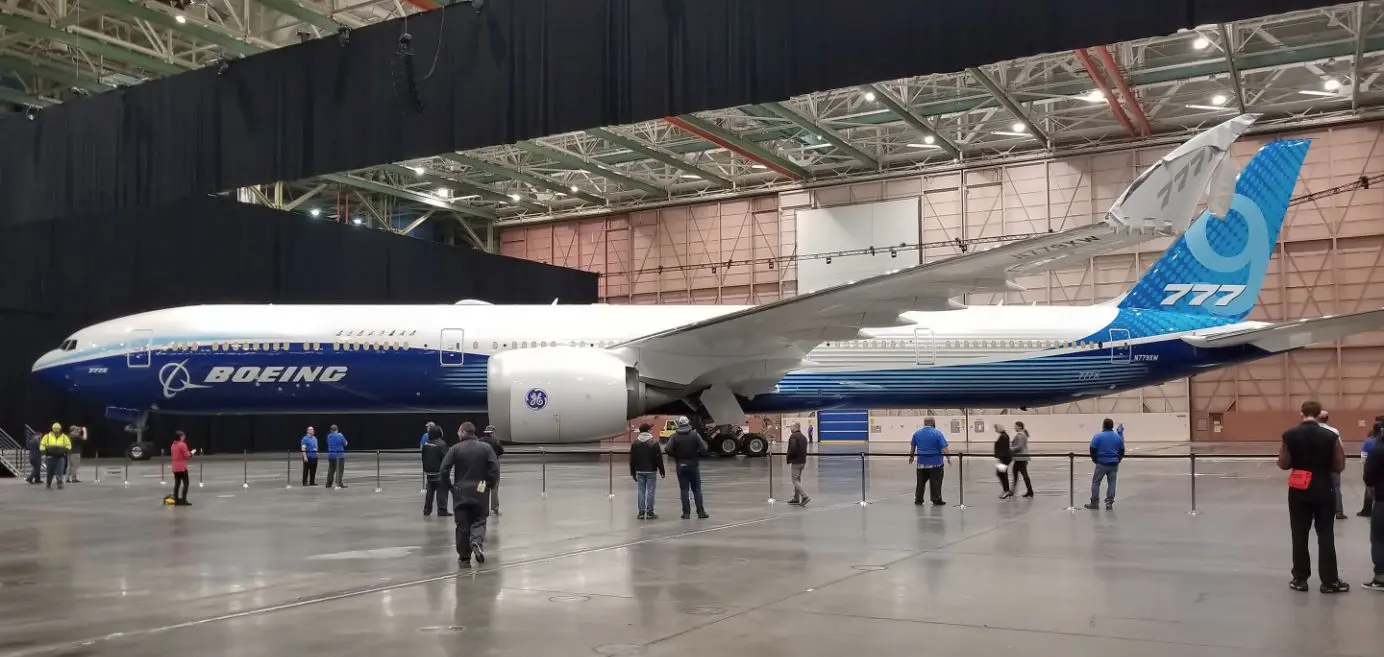
The Boeing 777-8 is the shortest variant in the 777X family (which also includes the 777-9) and is 229 feet long (69.8 meters). Boeing has emphasized lower fuel consumption and CO2 emissions and room for more passengers. The most significant upgrades from the previous Boeing 777 are new General Electric GE9X engines, wings made of composite materials, and a larger cabin with more seats.
The 777X has longer wings which improve the plane's lift-to-drag ratio and make room for more fuel. To maintain the same size category as the previous generation Boeing 777, the 777X is equipped with foldable wingtips that can be folded upwards. Therefore, it can serve the same airports as the 777s it replaces.
The 777-8 variant has room for 384 passengers. The new engines and lighter carbon fiber wings are expected to provide a lower fuel consumption per seat of 13% compared to a 365-seat Boeing 777-300ER. The Boeing 777-8 competes directly with the Airbus A350.
The first deliveries of the Boeing 777-8 and 777-9 have been delayed several times and are now expected in 2025.
No. 2 - Airbus A340-500
Range: 10,358 miles (16,670 km)
We find another Airbus on the list with a range of 10,358 miles (16,670 km). It is the Airbus A340-500.
When Airbus introduced the A340-500, it was the world's longest-range commercial airliner, and the aircraft first flew on February 11, 2002.

The four-engine Airbus A340-500 is derived from the Airbus A300, the first aircraft that Airbus developed, produced, and marketed. There is room for 313 passengers on board in a regular three-class layout.
Compared to the A340-300 from the same family, the -500 is longer, has larger wings, and has room for 50% more fuel, which helps give the aircraft its long range. The A340-500 can fly nonstop between London and Perth in Australia.
Unfortunately, the A340-500 was not popular with airlines, and they considered the aircraft too inefficient for the number of seats on board. In addition, the ultra-long-haul routes were a relatively narrow and unprofitable market, and the need for an aircraft with such a long range was limited. As a result, Airbus only built 34 A340-500s between 2003 and 2012.
At the time of writing, there are no A340-500s in commercial operation.
No. 1 - Airbus A350-900ULR
Range: 11,185 miles (18,000 km)
The aircraft with the longest range is the Airbus A350-900ULR (Ultra Long Range) which can fly 11,185 miles (18,000 km). It is a sub-variant of the A350-900.
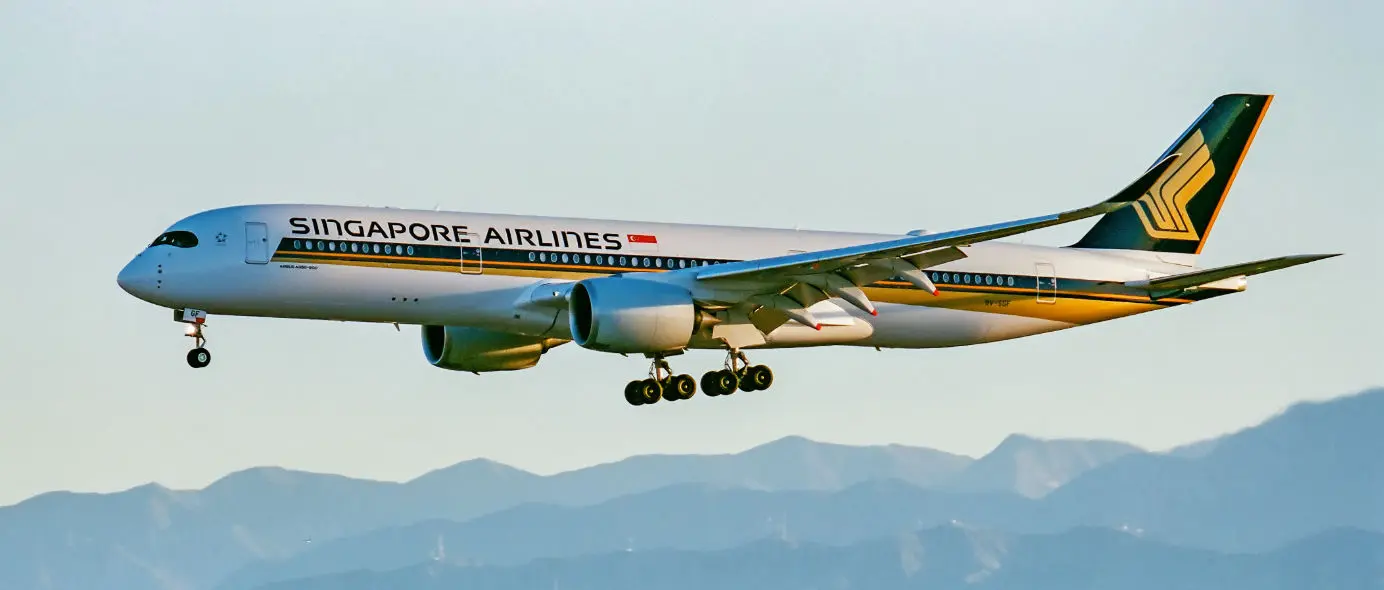
On the A350-900ULR, Airbus has increased fuel capacity from 37,000 to 44,000 US gal (141,000 to 165,000 liters). This allows the aircraft to fly for more than 20 hours nonstop, thus opening up new possibilities for routes.
The Airbus A350-900ULR first flew on April 23, 2018, and Airbus delivered the first aircraft to Singapore Airlines on September 23, 2018. At the time of writing, it is also the only airline operating the A350-900ULR, and they own seven in total. Singapore Airlines has operated the ULR between Singapore and New York.
From the outside, the A350-900ULR is identical to the regular -900 variant. However, due to the increased fuel requirement, the maximum take-off weight (MTOW) is slightly higher than the -900.
From a range point of view, the closest competitor is Boeing's 777-8, although it can't fly quite as far. The Airbus A340-500 does not count as a close competitor as the aircraft is practically phased out and no longer in commercial service.
Here are Some of the Longest Flights
The range isn't everything when an airline purchases new aircraft. Even so, a long range is sometimes essential to companies looking through the airliner market.
As we explained in the list above, the Airbus A350-900ULR is the commercial aircraft with the longest range. It can cover a distance of 11,185 miles (18,000 km) nonstop. The A350-900ULR is, therefore, also used to service some of the longest flight routes in the world.
The Singapore Airlines route from Singapore to New York JFK is flown with their Airbus A350-900ULR. This is the world's longest scheduled flight. It was established on November 9, 2020, and is 9,537 miles (15,349 km) long. The scheduled flight time is 18 hours and 50 minutes.
The second-longest flight in the world is also operated by Singapore Airlines. It is the route between Singapore and Newark and is also flown by their Airbus A350-900ULR. The route is 9,534 miles (15,344 km) long and takes 18 hours and 45 minutes.
Australian Qantas operates the third-longest route between Perth and London. Qantas uses a Boeing 787-9, and the flight is 9,009 miles (14,499 km) long. It takes 17 hours and 25 minutes.
Data is from March 2023.
Summary
The Airbus A350-900ULR (Ultra Long Range) is the commercial airliner with the longest range in the world. It can fly 11,185 miles (18,000 km) which translates to a flight time of up to 20 hours.
Its closest competitor is Boeing's 777-8, although it lags slightly behind the A350-900ULR, with a range of 10,048 miles (16,170 km). There are currently no other aircraft under development that can match these ranges.
Long aircraft ranges have enabled connections between destinations further apart than ever before. Whether these long ranges are attractive for passengers or airlines is another matter.
Also read:
Planenerd Newsletter
Join the newsletter to receive the latest updates in your inbox.






